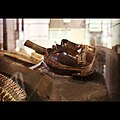File:Day 5 - Coffin of Nekht-ankh (8157262322).jpg
Day_5_-_Coffin_of_Nekht-ankh_(8157262322).jpg (612 × 419 pixels, file size: 59 KB, MIME type: image/jpeg)
Captions
Captions
Summary[edit]
| DescriptionDay 5 - Coffin of Nekht-ankh (8157262322).jpg |
Coffin of Nekht-ankh (Acc. 4739) This coffin is from the 12th Dynasty Tomb of the Two Brothers in Rifeh, Middle Egypt. It was donated in 1907 to the Manchester Museum by the British School of Archaeology in Egypt. It is the wooden inner coffin of a man named Nekht-ankh, and is 161cm in length. This coffin was designed to lie inside the rectangular outer coffin (acc. 4724). The inner coffin takes the shape of a wrapped mummy, wearing a divine tripartite wig and a large beaded collar, which helped protect the deceased. The body of the coffin is painted red and patterned in imitation of a blue-green beaded net, another protective design. The face of the coffin is painted black, a reference to the god of the dead Osiris. The eyes of the coffin are made of stone and inlaid, held by bronze rims; the short straight beard is another semi-divine feature of this coffin. Osiris was often shown with green or black skin because he was an agricultural god as well--black refers to the rich silt deposited on fields by the Nile flood, and green reflects the growth of new crops. Upon the unwrapping of the mummies (a decision made by Dr. Margaret Murray and Flinders Petrie, in order to further the discipline of archaeological research), the mummy of Nekht-Ankh was better preserved than that of Khnum-nakht. Although the body had fallen to pieces before unwrapping, the bones were intact and in position. Even some hair remained, and the embalmers had wrapped the nails of the fingers and toes with thread to prevent their loss during the process of mummification. He is considered to be aged about sixty at time of death. Unlike Khnum-nakht, Nekht-Ankh had a set of canopic jars and only two jars in the set had contents. These were identified as the liver with the gall bladder attached, and lung tissue to which adhered part of the wall of the heart. Examination revealed that Nekht-Ankh had suffered from pleurisy, and also from sand pneumoconiosis which may have been responsible for his death. The inscriptions on the coffins states that Khnum-Nakht was a 'Great Waab-priest' of the local god Khnum and both his father and grandfather bore the title of local mayor - although nether is named. The inscriptions referring to Nekht-Ankh are rather different. He is referred as the son of an unnamed local major but his paternal grandfather is not mentioned. However, the men were sons of the same woman. Aa-Khnumu. The slight variation in the inscriptions, taken in conjunction with the men's marked anatomical differences, may indicate that their mother had two husbands, and that the father of Khnum-Nakht possessed Nubian ancestry. During much of Egypt's history, there was a certain mingling of the peoples of Nubia with those of Egypt at all levels of society. However, it is accepted nowadays that a child may well inherit a marked similarity to one of his parents while having no resemblance at all to the other. This could well be the case with the two brothers, and one had the usual appearance of an Egyptian while the other had inherited the characteristic Nubian features. Another possibility, and equally likely explanation of this difference in appearance, is that Nekht-Ankh was adopted into the family at a very early age, and having been a member of it for so many years, had become accepted as the son of Aa-Khnumu.
Petrie, with the British School of Archaeology, was excavating in Egypt in the Giza and Asyut to Sohag region. At the very end of 1906 they surveyed the area around the village of Rifeh and finally completed their activities on 02-April-1907. The rock-tombs of Rifeh extend for a few hundred yards at about a third of the whole height of the cliffs. Those furthest north were occupied by Coptic burials. The cemetery of Rifeh is not absolutely dated by kings' names, except in the 18th and 19th dynasties. But by the style of its contents it largely belongs to the 12th dynasty and earlier. |
| Date | |
| Source | Day 5 - Coffin of Nekht-ankh |
| Author | akhenatenator |
Licensing[edit]
| This file is made available under the Creative Commons CC0 1.0 Universal Public Domain Dedication. | |
| The person who associated a work with this deed has dedicated the work to the public domain by waiving all of their rights to the work worldwide under copyright law, including all related and neighboring rights, to the extent allowed by law. You can copy, modify, distribute and perform the work, even for commercial purposes, all without asking permission.
http://creativecommons.org/publicdomain/zero/1.0/deed.enCC0Creative Commons Zero, Public Domain Dedicationfalsefalse |
| This image was originally posted to Flickr by akhenatenator at https://flickr.com/photos/86012097@N08/8157262322 (archive). It was reviewed on 18 December 2017 by FlickreviewR 2 and was confirmed to be licensed under the terms of the cc-zero. |
18 December 2017
File history
Click on a date/time to view the file as it appeared at that time.
| Date/Time | Thumbnail | Dimensions | User | Comment | |
|---|---|---|---|---|---|
| current | 11:36, 12 September 2023 |  | 612 × 419 (59 KB) | Sebastian Wallroth (talk | contribs) | Cropped 32 % vertically using CropTool with lossless mode. Removed border. |
| 09:22, 18 December 2017 |  | 612 × 612 (64 KB) | Donald Trung (talk | contribs) | Transferred from Flickr via Flickr2Commons |
You cannot overwrite this file.
File usage on Commons
There are no pages that use this file.
